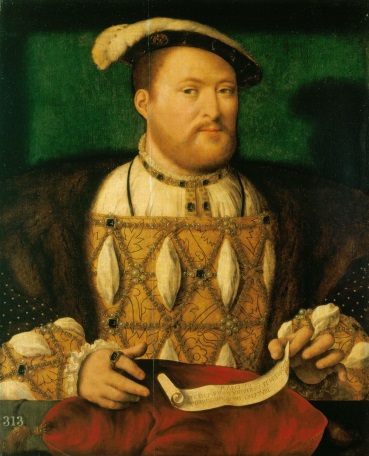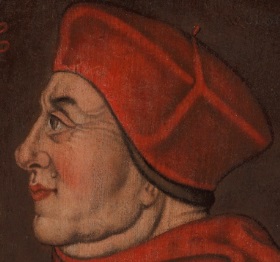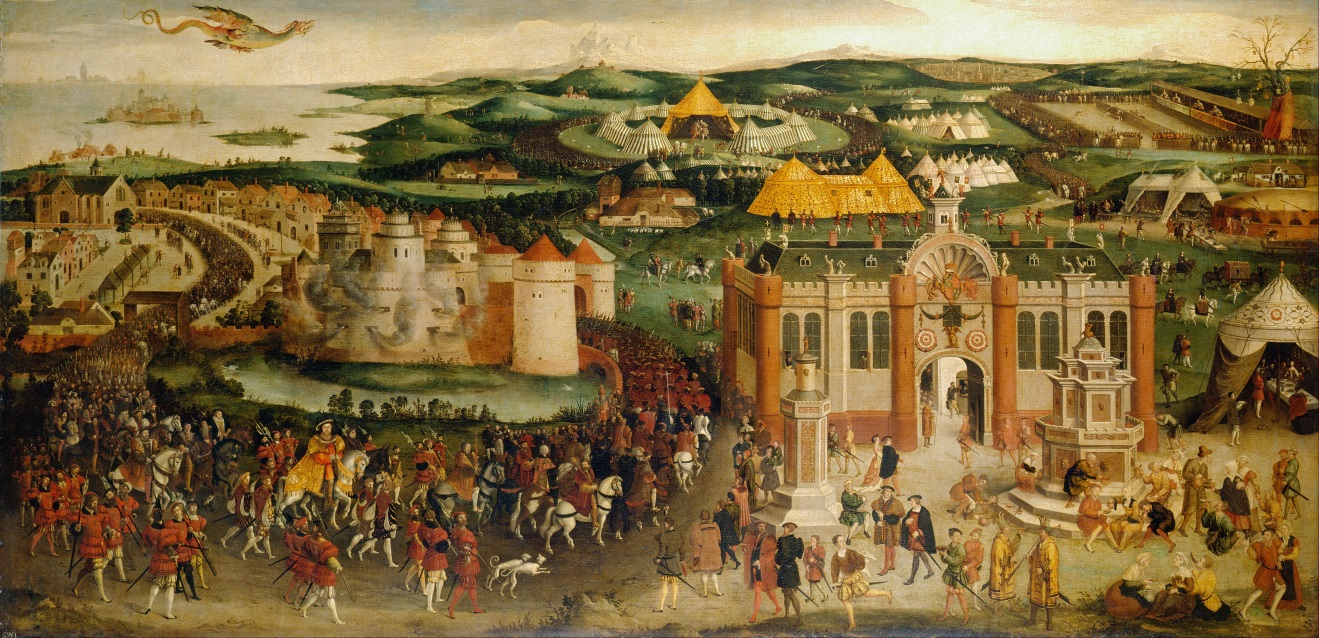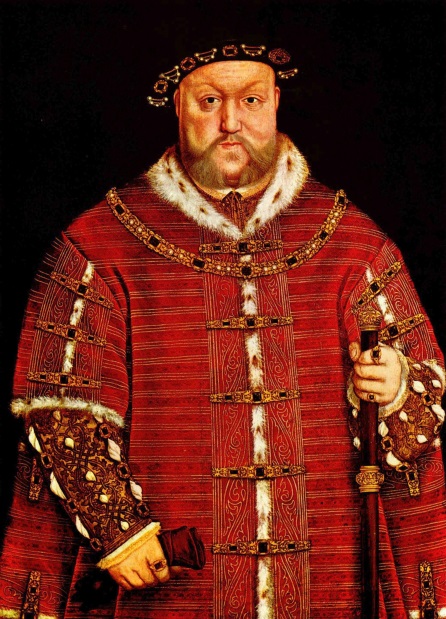Henry VIII
Henry VIII was his parents' second son, and thus was not initially expected to become King. Nevertheless, he was exceptionally well educated in every aspect of Renaissance knowledge. He spoke several languages and understood others; he wrote music, played various instruments to a high standard and had an active and enquiring intelligence on matters as diverse as mathematics and medicine. In addition, he was a tall, strong, handsome man who excelled at the fashionable athletic pursuits of hunting, tennis and tilting.
On the untimely death of his elder brother in 1501, Henry became heir to the throne. He lost his mother in early 1503 when he was just twelve, and this seems to have caused him great grief, and perhaps had a long-term effect on his personal relationships.

Towards the end of his father's reign, Henry was chafing under the restrictions the cautious and increasingly paranoid Henry VII imposed on him. So when he acceded to the throne in 1509, aged nearly eighteen, young Henry threw off all restraint and proceeded to indulge in every whim, from pageants and tournaments to the disposal on the block of two of his father's most efficient money-collectors, Sir Edmund Dudley and Sir Richard Empson. These were the first of the many show-trials of Henry's reign.
Henry had appointed his wife, Katharine of Aragon, as Regent during his absence in France, and it was she who, together with the Earl of Surrey, organised the repulsion of the invasion of England by King James IV of Scotland. James, Henry's brother-in-law, had invaded as France's ally. Despite numeric and technical superiority, James' army was routed at the Battle of Flodden on 9 th September 1513, and he himself killed.

During the next decade, Henry, who was a genius at finding the right man for the job, worked closely with his Chancellor, Cardinal Wolsey. Wolsey was unmatched at delivering the king's desires, but Henry was always the final arbiter. They pursued a policy of setting France and the Empire at loggerheads in order to keep England in a position to hold the balance of power. The culmination of this policy was in the extraordinary diplomatic visit known as the Field of Cloth of Gold, which took place in France in 1520.

By the mid-1520s Henry was faced with the problem of the succession. He had no son by his wife, only a daughter. Although there had been successful women rulers in other countries, notably his own wife's mother, Isabel of Castile, Henry was concerned about the risks of a female succession: the scars of the Wars of the Roses were not long healed.
Queen Katharine was now past child-bearing and his only son was illegitimate. It is clear that during the 1520s he was torn between accepting his daughter as his heir, sending her to Wales as de facto Princess of Wales (although she was not formally invested) and raising his bastard son to high rank and office, with a view to legitimising him, but neither solution was appealing to him.
Complicating the issue was the additional factor of a wild passion that overtook Henry in around 1526. He fell spectacularly in love with Anne Boleyn, an attendant of Queen Katharine and, foiled in his attempts to make her his mistress, decided that the best option all round would be to obtain an annulment of his marriage, marry Anne and have a string of boys. Kings had obtained annulments before on very flimsy excuses, and Henry had a pretty robust case to put to the Pope, showing his marriage to have been unlawful.Katharine had previously been his brother's wife.
The usual result in these cases was for all parties to pretend shock and distress at discovering their marriage to have been unlawful and for the wife to take herself off to a convent, usually with the children being declared legitimate, as the marriage had been an honest mistake.Unfortunately, Katharine refused to play ball, and was supported in her resistance by her nephew, Emperor Charles V, the most powerful man in Europe.
The Pope agonised over the decision. He wanted to please Henry, who had been a firm supporter of the Papacy, but Charles' troops had sacked Rome and held the Pope captive, limiting his choices. Perhaps a compromise would have been reached in any period before the 1520s but by this time the whole of Europe was ringing to the cries for reformation of a profoundly corrupt church. The Pope and the Emperor could not afford any admission that a previous Pope, who had given a dispensation for the marriage of Henry and Katharine, might have been wrong, or exceeded his powers.
Throughout the late 1520s the battle raged in England between Henry and Katharine.She had much public support, but his position was not without merit, canonically, as well as politically.
In the end, Henry lost patience with finding an accommodation with the Pope, and encouraged by Anne, who was strongly in favour of church reform, he threw off the authority of the Pope, and persuaded Parliament (not unwillingly, as the depredations of the church had disgusted many people) to declare him Supreme Head of the Church in England. The intention was not to adopt the budding Lutheran faith, but merely to reduce the church to obedience to the King.
Granted his annulment in 1533 by the new Archbishop of Canterbury, Thomas Cranmer, Henry quickly married Anne who soon gave birth to a daughter, Elizabeth. All seemed set fair, but, for reasons we cannot be sure of, whether a fundamental personality clash, or the realisation that the prize striven for could never match the delights of anticipation, the relationship between Henry and Anne fell apart.
By the summer of 1535, he was courting Jane Seymour, although whether this was with a view to matrimony or just as a mistress, must be a moot point. When Katharine of Aragon eventually died in January 1536, Anne was fatally exposed.She had a miscarriage within days, and it seems that for Henry, this was the final straw.
With frightening speed, Anne was arrested on what seem to be such ludicrous charges of adultery, incest and witchcraft that even Eustace Chapuys, the Imperial Ambassador, who was her staunchest enemy, considered them to be trumped-up.She was executed on 19 th May 1536, and Henry married Jane Seymour within days.

Religious traditionalists, who were no doubt hoping that the dispatch of Queen Anne would return the world to its rightful axis, were disappointed as Henry, ably assisted and abetted by his new chief minister, Thomas Cromwell, continued his assault on the institution, if not the doctrine, of the church.
The biggest transfer of land since the Norman Conquest had begun – the monasteries, which had become the repository of an enormous proportion of England's wealth were targeted as nests of Popish traitors. The process of dissolving them began and their vast treasure poured into Henry's hands. He used much of the money to establish his supremacy over the Church.
Men who had received large grants of church land were not going to vote to give it back, but he also used it more imaginatively in the enhancement of England's sea defences and the beginnings of a royal navy. The beautiful ship, the Mary Rose, and the fortifications that stretch around the southern coast of England from Deal to Portsmouth and Portland Bill are the visible results of Henry's dedication to military strength.

Unfortunately, not everyone saw the construction of Dover Castle as the justification for the destruction of Abbeys such as Jervaulx and Fountains and the shrine of St Thomas at Canterbury. The commons, with the connivance, if not active support, of a huge swathe of the gentry of the Midlands and the North rose in revolt, in what became known as the Pilgrimage of Grace, from the rebels bearing the banner of the Five Wounds of Christ.
The Pilgrimage of Grace was the most serious of all the Tudor rebellions, and was only put down by a mixture of guile and treachery on the part of Henry and his ministers. Following it, there was a bloody cull of any of the remaining sprigs of the House of York who could, at the furthest stretches of the imagination, be said to have been complicit. This included the beheading, without trial, of 69 year old Margaret Pole, Countess of Salisbury: his mother's cousin, his first wife's closest friend, and his daughter's governess.
However bloodily, the rebellion was put down and the country returned to a semblance of normality: traditionalists pacified with the passing of the Act of Six Articles in 1539 which rowed back from the more radical religious changes of the previous few years.
An annulment was quickly arranged, and Henry raced into yet another ill-considered match with a young girl of no more than twenty-one or -two, compared with his fifty. Unsurprisingly, Queen Katheryn Howard was not as enamoured of her new husband as she was of her former suitor, Thomas Culpepper, and the two were found guilty of adultery – although whether they committed the final act is debatable. Queen Katheryn and Culpepper lost their heads, as did the young man, Francis Derham, who had been her lover long before the King ever saw her.
Henry, bruised and hurt by this blow to his manhood, remained a widower for eighteen months, but in 1543 he married a more mature woman, Katherine Parr, a widow of thirty, and a friend of his elder daughter, Mary.
The new Queen was a charming and intelligent woman who developed excellent relationships with all three of the king's children and impressed Henry enough with her intellectual and political abilities for her to be appointed Regent when he undertook the final flourish of his reign – a further invasion of France.

In 1546, Henry, now vastly overweight and in severe pain from a multitude of ailments, realised that he would not live to see his son grow up. He drew up a complex will that aimed to keep both the traditionalist, Catholic party and the radical party, now increasingly referred to as “Protestant", in balance, just as he and Wolsey had aimed to hold the balance in Europe thirty years before.
However, even King Henry VIII could not command the world beyond the grave, and his wishes were manipulated to give the advantage to the Protestant party. He did, however, acknowledge the place in the succession of his two daughters, failing heirs from his son, Edward. He finally relinquished his hold on the realm in the early morning of 28 th January 1547, gripping the hand of Archbishop Cranmer.
Henry VIII was a colossus amongst kings – the most loved, the most hated, the most admired and the most feared of all the kings who ever sat on the English throne. His legacy surrounds us every day – the rise of England as a naval nation, the curious hybrid Anglican religion, the great castles and palaces he built and the enduring legend of the man with six wives that never fails to fascinate.
Henry VIII
Family Tree





